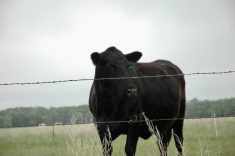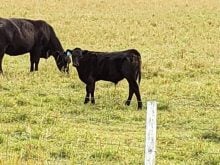During the last week of October, Alberta packers were buying fed cattle on a live basis at $297-299 per hundredweight FOB the feedlot.
This is down from levels of $312-315 per cwt. a month ago. The fed cattle market has been digesting price-negative comments from U.S. government officials over the past couple of weeks (see below).
The fundamentals for fed cattle are somewhat burdensome in the short term as U.S. cattle-on-feed inventories 180 days or more as of Oct. 1 are up about 66 per cent from last year. The feeder market has also come off the highs.
Read Also

Gentle treatments for pain in the neck
Heading toward year-end, people unknowingly tense up against the cold and busyness, causing neck pain that can often be treated with appropriate support and gentle mobility, athletic therapist Kathlyn Hossack says.
During the final week of October, yearlings off grass were down $10 per cwt. on average from the last week of September. Calves in the range of 575-850 pounds were also down about $10 on average. Certain pockets outside the major feeding regions of Western Canada were down as much as $15 per cwt. Calves under 575 lb. were relatively unchanged.
During the week of Oct. 19-25, U.S. President Trump took to social media telling ranchers and cattle producers that they needed to get the price of beef down. He also stated that the U.S. would allow 80,000 tonnes of beef imports from Argentina, up from the current limit of 20,000 tonnes. An additional 60,000 tonnes of beef from Argentina does little when spread over a population of 340 million.
The administration released a policy outlook that would open federal lands to grazing and also allow ranchers to implement protection measures against wildlife.
Buy American, but after buy Argentinian?
The government also stated they would have a “Buy American” policy to raise prices for cattle producers, which sounds like a contradiction of the earlier paragraph. In addition to comments from the White House, U.S. Agriculture Secretary Brooke Rollins said she will visit her Mexican counterpart over the next couple of weeks to discuss policies and procedures for reopening the U.S. border to Mexican feeder cattle.
This is the most significant change in policy, as analysts expected the U.S. government to keep the border closed until there was significant proof that New World screwworm was eradicated.
We didn’t receive the U.S. Department of Agriculture’s Oct. 1 Cattle on Feed Report due to the government shutdown. There, the trade is taking its clues on supplies from the pre-report estimates.
Cattle on feed as of Oct. 1, 2025 were estimated at 11.368 million head, down two per cent, or 232,000 head, from the Oct. 1 2024 number of 11.600 million head. Feeder cattle placements during September were estimated at 1.976 million head, down 8.4 per cent, or 180,000 head, from September 2024. U.S. feedlot marketings during September were estimated at 1.600 million head, down six per cent, or 98,000 head, from last year.
If we work through the supply and demand balance, it appears that U.S. cattle on feed 180 days or more are around 1.397 million head, up 66 per cent, or 556,000 head, from Oct. 1, 2025. There are quite a few cattle that are ready to come on the slaughter market over the next month.
Feedlot operators have been holding cattle to heavier weights, but this tends to turn when the monthly slaughter decreases. The U.S. November slaughter will be down about 170,000 head from October. Feedlots have larger supplies that they’re selling into lower demand, which is price negative from a fundamental standpoint.
Cattle on feed in Alberta and Saskatchewan as of Oct. 1, 2025, were 848,203 head, up one per cent, or 5,191 head, from the Oct. 1, 2024, number of 843,012 head. Feedlot placements during September were 250,405 head, up five per cent, or 12,184 head, from the September 2024. Marketings were 147,063 head, down six per cent, or 8,740 head, from 12 months earlier.
In Alberta and Saskatchewan, cattle on feed 180 days or longer as of Oct. 1 were 143,807 head, up 3.5 per cent, or 4,876 head, from Oct. 1, 2024. Cattle on feed 150 days or more as of Oct. 1 were 237,749 head, down two per cent, or 4,840 head, from last year. Feedlots are current in Western Canada.
The weaker live cattle futures have set a negative tone for the feeder market. Southern Alberta breakeven pen closeout values will increase moving forward.
For November, the breakeven fed cattle price is $296 per cwt., and the December profit line starts at $307 per cwt. For January, the fed cattle breakeven price is around $311 per cwt. For February and March, the breakeven fed cattle price is in the range of $318-322 per cwt.
The April live cattle futures are reflecting an average price of $308 in southern Alberta for March and April. If the futures don’t rally back up to the highs, the cattle bought during September and October will be severely underwater.
Expediting the reopening of the Mexican border has set a negative tone for Canadian and U.S. feeder cattle prices.
Given the U.S. and Canadian calf crop numbers over the past couple of years, the function of the feeder market is to ration demand and encourage production.
The market needs to move high enough so that feedlots endure one full round of negative margins, then we’ll see a significant decrease in feeder cattle prices.
We are seeing heifer retention in Western Canada. In the U.S., there isn’t mass retention from ranchers so far, but the cow slaughter for 2025 will be at the lowest levels since 2016. Lower cow slaughter is the first sign the market is in an expansionary environment. Major heifer retention will likely occur in the fall of 2025 and the first half of 2026.
The highs are likely in place on the fed and feeder cattle markets. For cow-calf producers and ranchers, make sure you have your price insurance in place. Feedlot operators need to be careful because the market is working against you.
















